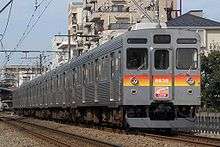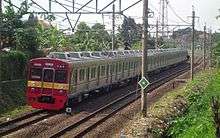Tokyu 8500 series
| Tokyu 8500 series | |
|---|---|
|
A 10-car Den-en-toshi Line 8500 series set | |
| In service | 1975–Present |
| Manufacturer | Tokyu Car Corporation |
| Constructed | 1975–1991 |
| Number built | 400 vehicles |
| Number in service | 280 |
| Formation |
5/10 cars per trainset (Tokyu) 8 cars per trainset (KRL Jabodetabek) |
| Operator(s) |
Tokyu Corporation KRL Jabodetabek (2006-present) |
| Depot(s) | Nagatsuta |
| Line(s) served | Tokyu Den-en-toshi Line, Tokyu Oimachi Line, Tokyo Metro Hanzomon Line, Tobu Isesaki Line, Tōbu Nikkō Line, Tobu Skytree Line |
| Specifications | |
| Car body construction | Stainless steel |
| Car length | 20,000 mm (65 ft 7 in) |
| Doors | 4 pairs per side |
| Maximum speed |
Service: 110 km/h (70 mph) Design: 120 km/h (75 mph) |
| Acceleration | 3.3 km/h/s |
| Deceleration |
3.5 km/h/s 4.5 km/h/s (Emergency) |
| Electric system(s) | 1,500 V DC |
| Current collection method | overhead |
| Track gauge | 1,067 mm (3 ft 6 in) |
The Tokyu 8500 series (東急8500系 Tōkyū 8500-kei) is a commuter electric multiple unit (EMU) train type operated by the private railway operator Tokyu Corporation on the Tokyu Den-en-toshi Line and Tokyu Oimachi Line in the Tokyo area of Japan since 1975.[1]
Design
First introduced in 1975, the design is based on the earlier 8000 series design.[2] A total of 400 vehicles were built by 1991.[1]
Operations
The 10-car trainsets are primarily used on inter-running services on the Tokyu Den-en-toshi Line, Tokyo Metro Hanzomon Line, Tobu Skytree Line, Tobu Isesaki Line as far as Kuki, and Tobu Nikko Line as far as Minami-Kurihashi.[3] The five-car sets are used on Tokyu Oimachi Line services.[3]
Formations
Den-en-toshi Line 10-car sets
As of 1 April 2014, the fleet consists of 26 ten-car sets, based at Nagatsuta Depot, and formed as shown below with eight motored ("M") cars and two non-powered trailer ("T") cars, and car 1 at the Shibuya end.[3]
| Car No. | 1 | 2 | 3 | 4 | 5 | 6 | 7 | 8 | 9 | 10 |
|---|---|---|---|---|---|---|---|---|---|---|
| Designation | M2c | M1 | T | M2 | M1 | M2 | M1 | T | M2 | M1c |
| Numbering | DeHa 8600 | DeHa 8700 | SaHa 8900 | DeHa 8800 | DeHa 8700 | DeHa 8800 | DeHa 8700 | SaHa 8900 | DeHa 8800 | DeHa 8500 |
- Cars 2, 5, 7, and 10 are each fitted with one lozenge-type pantograph.[3]
- Cars 3 and 9 have a wheelchair space.[3]
- Car 2 is designated as a mildly air-conditioned car.[3]
Den-en-toshi Line sets 8601 to 8614 were marked with "K" stickers on the center front window of the driving cab ends, and they were restricted to operating on Den-en-toshi Line and Tokyo Metro Hanzōmon Line only, due to lack of Tobu ATS on these sets. After the opening of the Hanzōmon Line extension from Suitengūmae Station to Oshiage Station, sets 8601, 8602, 8613, and 8614 were fitted with Tobu ATS, allowing them to operate on Tobu Skytree Line, Tobu Isesaki Line and Tōbu Nikkō Line (and had their "K" stickers removed), while sets 8603 to 8612 were retained without Tobu ATS until their retirement from duties on the Den-en-toshi Line.
Oimachi Line 5-car sets

As of 1 April 2014, the fleet consists of four five-car sets, based at Nagatsuta Depot, and formed as shown below with four motored ("M") cars and one non-powered trailer ("T") car, and car 1 at the Oimachi end.[3]
| Car No. | 1 | 2 | 3 | 4 | 5 |
|---|---|---|---|---|---|
| Designation | M2c | M1 | T | M2 | M1c |
| Numbering | DeHa 8600 | DeHa 8700 | SaHa 8900 | DeHa 8800 | DeHa 8500 |
- Cars 2 and 5 are each fitted with one single-arm pantograph.[3]
- Car 2 is designated as a mildly air-conditioned car.[3]
Interior
-

Early style interior of a Den-en-toshi Line set, February 2007
-

Later-batch style interior of a Den-en-toshi Line set, February 2007
-

LED passenger information display
Livery variations
-

Blue stripe livery, June 2007
-

Izu no Natsu Izu Kyuko style livery, August 2012
-

"TOQ-BOX" livery, June 2007
Resale
A number of 8500 series trains have been resold to other operators in Japan and overseas following their withdrawal from Tōkyū services.
Nagano Electric Railway

Six 3-car sets were sold to the Nagano Electric Railway between 2005 and 2009. These retain the "8500 series" classification.[2]
Formation
- DeHa 8500 (M1c)
- SaHa 8550 (T)
- DeHa 8510 (M2c)
Izukyū Corporation
One 8500 series car (DeHa 8723) was sold to Izukyū Corporation in 2006, becoming KuMoHa 8152, and combined with former Tokyu 8000 series cars. It includes transverse seating acquired from Seibu 10000 series trains during refurbishment.[2]
Chichibu Railway

Two 3-car 7000 series sets were formed from cars of set 8609, entering service on the Chichibu Railway in 2009.[2]
Indonesia

Eight 8-car sets (8604, 8607, 8608, 8610, 8611, 8612, 8613, and 8618) were sold to KRL Jabodetabek in Indonesia between 2006 and 2009 for use on commuter services in the Jakarta area.[2][4] The sets initially received different color schemes, but were later standardized with the same KA Commuter Jabodetabek red and yellow livery.[5]
References
- 1 2 私鉄車両年鑑2013 [Japan Private Railways Annual 2013]. Tokyo, Japan: Ikaros Publications Ltd. 20 March 2013. p. 182. ISBN 978-4-86320-693-9.
- 1 2 3 4 5 "東急8500系と田園都市線のあゆみ" [Tokyu 8500 series and the History of the Denentoshi Line]. Tetsudō Daiya Jōhō. Japan: Kōtsū Shimbunsha. 38 (301): 12–21. May 2009.
- 1 2 3 4 5 6 7 8 9 私鉄車両編成表 2014 [Private Railway Rolling Stock Formations - 2014]. Japan: Kotsu Shimbunsha. 24 July 2014. pp. 61–64. ISBN 978-4-330-48414-3.
- ↑ "インドネシアで活躍する日本の電車2009 (Japanese EMUs active in Indonesia 2009)". The Railway Pictorial. Japan. 59 (824): 102–107. October 2009.
- ↑ "Warna-warni Rangkaian KRL AC Jabodetabek Dari Masa ke Masa" [The Colorful Jabodetabek EMU from Time to Time] (in Indonesian). Indonesia: Kaori Nusantara. 21 October 2015. Retrieved 14 September 2016.
| Wikimedia Commons has media related to Tōkyū 8500 series. |
